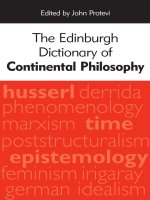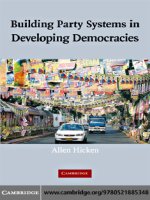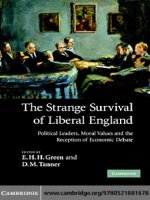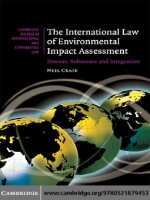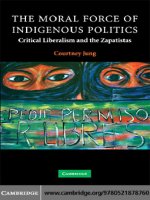052150970X cambridge university press the judicial assessment of expert evidence jan 2009
Bạn đang xem bản rút gọn của tài liệu. Xem và tải ngay bản đầy đủ của tài liệu tại đây (2.22 MB, 469 trang )
This page intentionally left blank
THE JUDICIAL ASSESSMENT
OF EXPERT EVIDENCE
THE JUDICIAL ASSESSMENT
OF EXPERT EVIDENCE
´
D EIRDRE
DWYER
CAMBRIDGE UNIVERSITY PRESS
Cambridge, New York, Melbourne, Madrid, Cape Town, Singapore, São Paulo
Cambridge University Press
The Edinburgh Building, Cambridge CB2 8RU, UK
Published in the United States of America by Cambridge University Press, New York
www.cambridge.org
Information on this title: www.cambridge.org/9780521509701
© Deirdre Dwyer 2008
This publication is in copyright. Subject to statutory exception and to the
provision of relevant collective licensing agreements, no reproduction of any part
may take place without the written permission of Cambridge University Press.
First published in print format 2008
ISBN-13
978-0-511-46363-1
eBook (EBL)
ISBN-13
978-0-521-50970-1
hardback
Cambridge University Press has no responsibility for the persistence or accuracy
of urls for external or third-party internet websites referred to in this publication,
and does not guarantee that any content on such websites is, or will remain,
accurate or appropriate.
For William
CONTENTS
List of figures
Preface
page xii
xiii
Table of legislation
1
xv
Table of cases
xxii
Introduction
1
General epistemological issues
1.1
1.2
1.3
1.4
1.5
1.6
9
Introduction
9
Classical epistemology
14
Legal epistemology
19
1.3.1 What is ‘legal epistemology’?
19
1.3.2 Why is legal epistemology special?
21
1.3.3 Institutional variations affecting legal epistemology
29
Justifying legal belief
40
1.4.1 Meta-justification: the Rationalist Tradition of
evidence scholarship
42
1.4.2 Atomistic reasoning about individuated propositions
of evidence
53
1.4.3 Generalizations as inferential glue
60
The challenge of naturalized epistemology
64
1.5.1 Strategies and shortcomings of social judgment
66
1.5.2 How people process complex specialist information
69
Conclusion
70
2. Expert evidence as a special case for judicial assessment
2.1
2.2
Introduction
74
Questions of fact and opinion
76
2.2.1 The nature of the distinction in English law
78
2.2.2 Operative rationales for the distinction
80
2.2.3 Philosophical difficulties with the distinction
87
vii
74
viii
contents
2.2.4
2.3
2.4
2.5
2.6
3.
Should legal epistemology distinguish facts
from opinions?
96
The court’s access to specialist knowledge
97
2.3.1 Substance-blind evidential reasoning
98
2.3.2 Common investigative method
104
2.3.3 Did Hand really present a paradox?
108
Persistent communities of practice
110
Epistemological constructivism
113
2.5.1 Definition
114
2.5.2 Epistemological constructivism in modernity
2.5.3 Strong epistemological constructivism
118
2.5.4 Autopoietic social systems theory
122
Conclusion
130
Making sense of expert disagreement
3.1
3.2
3.3
3.4
3.5
3.6
3.7
116
133
Introduction
133
Legal and expert factual disagreement
135
3.2.1 The need for finality in legal fact finding
135
3.2.2 Reasons for disagreement in expert fact
finding
136
3.2.3 Law’s perception of scientific knowledge as
objective certainty
138
The selection of generalization sets
139
3.3.1 Scientific realism
140
3.3.2 Logical positivism
141
3.3.3 Scientific constructivism
143
The application of generalizations to base facts
144
3.4.1 Disagreement in interpretation is accepted
145
3.4.2 Experts do not normally address such questions
145
3.4.3 Courts require special categories to be used
146
3.4.4 Specifics from generals
146
Types of inferential challenge
147
3.5.1 The condition of a property
149
3.5.2 Quantum of damages in personal injury
149
3.5.3 Causation in personal injury
150
3.5.4 Causation in toxic torts
151
3.5.5 The best interests of the child
155
3.5.6 The standard of care in professional negligence
159
Expert bias
163
3.6.1 Expert disagreement resulting from bias
163
3.6.2 The manifestations of actual bias
172
3.6.3 Personal and structural bias
176
Conclusion
178
contents
4.
Non-epistemological factors in determining the role
of the expert
180
4.1
4.2
4.3
4.4
5.
ix
Introduction
180
Five approaches to civil expert evidence
184
4.2.1 England and Wales: Civil Procedure Rules 1998
184
4.2.2 United States of America: Federal Rules of
Evidence 1975
188
4.2.3 France: Nouveau code de proc´edure civile 1975
192
4.2.4 Germany: Zivilprozessordnung 1933
195
4.2.5 Italy: Codice di procedura civile 1940
196
Five non-epistemological factors in expert role definition
197
4.3.1 The social function of civil litigation
198
4.3.2 The role of facts in civil procedure
212
4.3.3 The appropriate conduct of civil litigation
220
4.3.4 The status of experts in society
232
4.3.5 The historical use of experts
234
Conclusion
236
Assessing expert evidence in the English civil courts: the
sixteenth to twentieth centuries
238
5.1
5.2
5.3
5.4
5.5
5.6
5.7
5.8
Introduction
238
Tracing the history of civil expert evidence, 1500–1800
240
5.2.1 Source analysis
240
5.2.2 Civil courts before the Judicature Acts 1873 and 1875
244
Party experts
246
5.3.1 Early uses of party experts
246
5.3.2 The developing complexity of inferential questions
249
5.3.3 Increasing reliance on party expert evidence
253
5.3.4 Developments in the criminal courts in the
seventeenth and eighteenth centuries
256
5.3.5 The problem of party expert disagreement
258
Special juries
261
Assessors
263
5.5.1 The rise of the Trinity Masters
263
5.5.2 From Trinity Masters to assessors
266
Court experts
269
5.6.1 Before the nineteenth century
269
5.6.2 Nineteenth-century innovation
271
5.6.3 Twentieth-century disinterest
272
The Ultimate Issue Rule
274
5.7.1 The rule’s nineteenth-century rise
274
5.7.2 The rule’s twentieth-century decline
277
Conclusion
279
x
contents
6.
Assessing expert evidence in the English
civil courts today
282
6.1
6.2
6.3
6.4
6.5
7.
Introduction
282
Party experts
284
6.2.1 Selecting party experts
284
6.2.2 Producing full pleadings
294
6.2.3 Challenging expert opinion
294
6.2.4 Delegating fact finding
306
Single joint experts
307
6.3.1 Selecting single joint experts
307
6.3.2 Producing full pleadings
312
6.3.3 Challenging expert opinion
312
6.3.4 Delegating fact finding
313
Assessors
315
6.4.1 Selecting assessors
315
6.4.2 Producing full pleadings
321
6.4.3 Challenging expert opinion
323
6.4.4 Delegating fact finding
332
Conclusion
332
The effective management of bias
7.1
7.2
7.3
7.4
7.5
7.6
7.7
7.8
Introduction
334
The use of single experts
335
The presumptive recusal of an expert for bias
338
The inadmissibility of unreliable expert evidence
341
Exhortations to an overriding duty to the court
347
7.5.1 The nature of the overriding duty
348
7.5.2 The nature of the overridden obligations
351
The reform of litigation privilege
352
Criminal, civil and professional sanctions
358
7.7.1 Criminal sanctions
358
7.7.2 Civil sanctions
360
7.7.3 Disciplinary sanctions
361
Conclusion
363
Conclusion
1
2
3
334
366
Specialist knowledge and non-specialist courts
367
Arranging legal processes to best support accurate
fact determination
369
The foundational norms of evidence law
370
contents
Appendix 1: Part 35 of the Civil Procedure Rules 1998
Appendix 2: Tables of pre-1800 civil cases involving
expert evidence
379
Bibliography
Index
413
388
xi
374
FIGURES
1.1
1.2
1.3
2.1
2.2
Corroboration in inferential argument
Contradiction in inferential argument
Convergence and conflict in inferential argument
Normatively closed systems can exist within society
The incommensurability of normatively closed systems
xii
page 56
56
57
124
125
PREFACE
This project began with an interest in two relatively recent developments
in expert evidence in the civil courts of England and Wales. The first was
the 1997 decision of the House of Lords in the case of Bolitho v. City and
Hackney Health Authority, which appeared to introduce the possibility that
a judge sitting at first instance might be able to assess for herself, based on
expert evidence, whether a medical professional had been negligent. The
second was the extensive reform of the use of expert evidence effected by
the Civil Procedure Rules (CPR) 1998. Expert evidence had been one of
the two principal areas of concern in the course of Lord Woolf ’s Access to
Justice enquiry, the other being uncontrolled discovery. At that time, Lord
Justice Judge and several High Court and District judges and masters,
interviewed anonymously, were more than generous with their time in
discussing these issues from a judicial perspective. More recently, Master
Foster has very kindly read a draft of the chapter on experts under the CPR,
and provided suggestions, and Senior Costs Judge Hurst has provided
advice on the use of costs assessors.
As is perhaps too often the case, what seemed at first blush to be a
nicely defined area of enquiry unfolded to reveal a multiplicity of issues.
I focussed my attention on two key issues among many: first, ‘how can
courts, which lack specialist knowledge, assess the evidence of experts?’
(a question which seems to be posed more by theorists); secondly, ‘how
should we best arrange our use of experts to assist the court in addressing
issues requiring specialist knowledge?’ (a question which seems to be
posed more by practitioners). These questions are inextricably bound
up together, and in order to answer the one it is necessary to address
also the other. They are also non-trivial questions, and addressing them
has required investigations into the philosophy of law, epistemology and
comparative civil procedure.
It is not possible to thank individually by name all those who have been
of assistance, but among those to whom I am indebted are Neil Jones,
Patrick Glenn and the late Henrik Zahle. Matilde Betti, David Nelken,
xiii
xiv
preface
Paolo Biavati and Andrea Tassi provided information and advice on expert
evidence in Italy and the use of court experts. I am similarly indebted to
Olivier Leclerc and Rafael Encinas de Munagorri for France, and Erica
Beecher-Monas for the United States. I should like to give especial thanks
to the estate of Boris Anrep, for generously giving permission to use, as
the cover illustration for this book, the Boris Anrep mosaic ‘Open Mind’,
from his Modern Virtues at the National Gallery.
Some parts of this book have previously appeared elsewhere. An earlier
and shorter version of Chapter 7 was published in 2007 as ‘The Effective
Management of Bias in Civil Expert Evidence’ in volume 26 of the Civil
Justice Quarterly (pp. 57–78). An earlier version of Section 3.6 appeared
in the same volume as ‘Causes and Manifestations of Bias in Civil Expert
Evidence’ (pp. 425–46). Section 6.4 began life in 2006 as ‘The Future of
Assessors under the CPR’, in volume 25 of the same journal (pp. 219–31),
but has undergone significant revision. Chapter 5 has been developed
out of an article on ‘Expert Evidence in the English Civil Courts, 1550–
1800’, published in 2007 in volume 28 of the Journal of Legal History
(pp. 93–118).
Above all, this project could never have come to fruition without the
assistance, guidance and support of my two mentors in its course, William
Twining and Adrian Zuckerman.
The writing of this book has been made possible through the support
of the British Academy, in its award to me of a Postdoctoral Fellowship.
D´eirdre Dwyer
The British Academy, London
Feast of St John of the Cross, 2007
TABLE OF LEGISLATION
Australia
Federal Court Rules
Ord. 34B 330
Queensland Uniform Civil Procedure Rules
Ch. 11, Pt 5 311
England and Wales
Access to Justice Act 1999
s. 27 169
Asylum and Immigration Tribunal (Procedure) Rules 2005 (SI 2005/230 L.1)
r. 51(1) 30
British North America (Seigniorial Rights) Act 1825 (Imperial) (6 Geo. IV c. 59)
s. 4 242
Chancery Reform Act 1852 (15 & 16 Vict. c. 80)
s. 42 243
Children Act 1989 166
s. 1(1) 156
s. 7 212
s. 25 156
Civil Evidence Act 1972 277
s. 3 32
Civil Evidence Act 1995
s. 1 32
Civil Procedure Act 1997
s. 1(3) 208
Civil Procedure (Amendment No. 2) Rules 2000 316
Civil Procedure Rules 1998 (SI 1998/3132) 4, 188, 198, 207–11, 232, 238, 282–7, 311,
314, 334, 355
Pt 1 187, 282, 283
r. 1.1 26, 32, 170, 185, 208, 227, 282, 285, 292–3
xv
xvi
table of legislation
r. 1.2 209
r. 1.3 209, 211, 349
r. 1.4 209
r. 3.1 150
Pt 7 287
r. 9.2 287
r. 26.6 286
26 PD 9.1 286
r. 27.5 286
r. 27.14 286
Pt 28
28 PD 3.9 286
r. 31.14 353
r. 32.1 185, 189, 309
Pt 35 184, 186, 210, 237, 281, 282, 292, 293, 314, 317, 331,
339
r. 35.1 184, 189, 308
r. 35.2 186, 294, 296, 312, 318, 333
r. 35.3 168, 177, 187, 309, 347, 348–51, 353, 360–1
r. 35.4 185, 186, 296, 309, 357
r. 35.5 186, 286, 296, 300, 309
r. 35.6 186, 296, 312, 325
r. 35.7 170, 187, 287, 307, 309, 312, 316, 335
r. 35.8 187, 318
r. 35.9 32, 170, 187, 309
r. 35.10 168, 186, 353, 356–7
r. 35.11 186
r. 35.12 187, 297, 300, 312
r. 35.13 186
r. 35.14 185, 309
r. 35.15 187, 267, 281, 315–19, 323, 325, 327
35 PD 283, 318
35 PD 2.2 307, 310
35 PD 5 311
35 PD 7.4 325
r. 44.3 202
r. 47.26 (repealed) 316
r. 61.12 331
r. 61.13 283, 316, 322, 331
Common Law Procedure Act 1854 271
County Courts Act 1888
s. 103 267, 315
table of legislation
xvii
County Courts Act 1984
s. 63 268, 316
Court of Chancery Act 1852 (15 & 16 Vict. c. 80)
s. 42 271
Court of Probate Act 1857 (20 & 21 Vict. c. 77) 235
Courts and Legal Services Act 1990
Pt II 224
s. 58 169, 226
s. 58A 169, 226
Criminal Justice Act 2003 31
s. 321 36
Criminal Procedure (Insanity and Unfitness to Plead) Act 1964
s. 4A 29
Criminal Procedure and Investigations Act 1996
s. 3(1) 355
Criminal Procedure Rules 2005 (SI 2005/384 L.4)
r. 1.1 355
Divorce and Matrimonial Causes Act 1857 (20 & 21 Vict. c. 85) 235
Family Law Reform Act 1969
s. 20 (as amended) 212
Family Proceedings Rules 1991 (SI 1991/1247)
r. 2.22 212
r. 2.61C 212
r. 4.23 354
High Court of Admiralty Act 1859 (22 & 23 Vict. c. 6) 235, 267
Housing Act 1985
s. 604 (as amended) 149
Human Rights Act 1998 188
s. 6 325
Medical Act 1858 111
Merchant Shipping Act 1854 (17 & 18 Vict. c. 104)
s. 434 263
National Insurance (Industrial Injuries) (Determination of Claims and Questions)
Regulations 1948 268, 330
Perjury Act 1911
s. 1 358–9
s. 13 358
Pilotage Act 1987 112
Police and Criminal Evidence Act 1984
s. 78 32
Prisoner’s Counsel Act 1836 687 Wm. IVc. 114 275
Rules of the Supreme Court 1965 (SI 1965/1776 L.23) 198, 201, 208, 210, 217, 267,
282, 296–7, 304, 348
xviii
table of legislation
Ord. 38, rr. 36, 37 210
Ord. 38, r. 38 296
Ord. 40 189, 268, 272, 280, 308–9, 335
Ord. 40, r. 1 273, 309
Ord. 40, r. 2 273
Ord. 55, r. 19 271
Ord. 62 316
Ord. 70, r. 1 201
Supreme Court Act 1981
s. 70(1) 268, 316
s. 70(3) 267, 315
Supreme Court of Judicature Act 1873 (36 & 37 Vict. c. 66)
s. 56 266, 315
Supreme Court of Judicature Act 1875 (38 & 39 Vict. c. 77)
Workmen’s Compensation Act 1925 329
s. 38 268, 330
Sch. 1, para. 5 268, 315
184, 200, 246, 266, 282
184, 200, 235, 246, 266
France
Code civil (1804)
art. 10 9, 26, 27, 206, 207, 217, 349
art. 312 215
arts. 1315–69 215
art. 1320 216
arts. 1349–53 215
art. 1349 215
art. 1350 215
arts. 1357–69 216
art. 1363 216
Code de proc´edure civile (1806) 194–5, 198, 199, 203, 282, 338
Code de proc´edure p´enale (1958)
art. 159 (as amended) 338
Decree no. 2004–1463 of 23 December 2004 193
Law no. 71–498 of 29 June 1971, Journal Officiel 30 June 1971 193
Law no. 72–626 of 5 July 1972, Journal Officiel 9 July 1972 9
art. 12 206
Law no. 80–538 of 16 July 1980, Journal Officiel 17 July 1980 200
Law no. 2000–230 of 13 March 2000, Journal Officiel 14 March 2000
art. 1 216
Law no. 2004–130 of 11 February 2004, Journal Officiel 12 February 2004
Nouveau code de proc´edure civile (1975) 192–5, 196, 198, 205–7, 282
art. 1 206
193
table of legislation
art. 4 206
art. 5 206
art. 7 206
art. 11 206, 349
art. 12 206
arts. 14–17 206
art. 133 200
art. 161 197
art. 162 197
art. 188 200
art. 198 200
arts. 200–3 224
arts. 204–31 206
arts. 213–14 207
art. 218 206
arts. 232–84 192
art. 232 192
art. 234 194, 338
art. 238 194
art. 242 193
art. 246 194
arts. 249–55 192
art. 249 192
arts. 256–62 192
art. 256 192
art. 258 192
art. 263–84 192
art. 263 192
art. 274 193
art. 276 197
art. 341 194, 338
Germany
Reichscivilprocessordnung (1877) 203
Zivilprozessordnung (1933) 26, 195–6, 198, 203–4
s. 138 26
s. 139 26, 204, 349
s. 286 196
ss. 402–14 195
s. 402 195
s. 404 195
s. 404(2) 195
xix
xx
table of legislation
s. 404(4) 195
s. 404(7) 195
s. 404a 195
s. 404a(1) 196
s. 406(1) 195
s. 406(5) 195
s. 411(3) 195
s. 412 (1) 196
ss. 445–51 204, 349
s. 452 204, 349
International treaties
EC Treaty
Art. 222 324
European Convention on Human Rights and Fundamental Freedoms 1950
Art. 6 34, 185, 307
Art. 6(1) 194, 292, 295, 317, 318, 323, 325–9, 331, 333, 339
Art. 6(3) 295
International Convention on the Rights of the Child 1998
Art. 3(1) 156
Italy
Codice di procedura civile (1940) 196–7, 198, 204–5, 227
art. 61 196
art. 63 197
art. 70 211
art. 87 197, 349
art. 115 211
arts. 172–9 196
art. 175(1) 205
art. 192 197
art. 195 196
art. 201 197
Codice di procedura civile del regno d’Italia (1865) 196, 203
United States
Constitution of the United States of America (1787)
Art. III 37, 223
189
table of legislation
Federal Rules of Civil Procedure (1938) 188, 227
r. 1 227, 235
r. 11 225
r. 26(a)(2) 189
r. 26(f) 227
Federal Rules of Evidence (1975) 183, 188–91, 218, 343
r. 102 9, 26, 27, 28, 188
Art. III 217
r. 402 188, 191, 342
r. 403 32, 189
Art. VII 189
r. 701 189
r. 702 189
r. 703 189
r. 704 189, 277
r. 705 189
r. 706 189, 190, 335
Uniform Rules of Evidence 1974 183
Art. VII 189
xxi
TABLE OF CASES
Australia
Clark v. Ryan (1960) 130 CLR 486 95, 277
Ebner v. The Official Trustee in Bankruptcy and Clenae Pty Ltd v. ANZ Banking Group
Ltd [2000] HCA 63 341
F v. R (1983) 33 SASR 189 194 162
Genetics Institute Incorporated v. Kirin-Amgen Incorporated (No. 2) (1997) 149 ALR
247 330
Goode v. Nash (1979) 21 SASR 419 162
Lynch v. Lynch (1965) 8 FLR 433 157
R. v. Barker (1988) 34 A Crim R 141 95
R. v. Bonython (1984) 38 SASR 45 320
Re JRL ex p. CJL (1986) 161 CLR 342 330
Rogers v. Whitaker [1992] ALJR 47 162
Canada
Anderson v. Chasney [1949] 4 DLR 71, aff’d 4 DLR 223 162
Crits v. Sylvester [1956] 1 DLR (2d) 502, aff’d [1956] SCR 991
Dorion v. Roberge [1991] 1 SCR 374 162
Phillips v. Ford Motor Co. [1971] 18 DLR (3d) 641 277
R. v. Stinchcombe (1991) 68 CCC (3d) 1 355
162
England and Wales
(1354) YB Trin. 28 Edw. 3 pl. 1 fo. 18b 265
(1354) 28 Edw. 3 Lib. Ass. 5 fo. 145b 265
(1494) YB Hil. 9 Hen. VII 16 pl. 8 269
A v. B [2003] EWHC 1376 Fam 175
A v. Secretary of State for the Home Department [2004] UKHL 56; [2005] 2 AC 68;
[2005] 2 WLR 87; [2005] 3 All ER 169 276
xxii
table of cases
xxiii
A v. Secretary of State Home Department [2004] EWCA Civ 1123; [2005] 1 WLR 414
211
Abbey National Mortgages plc v. Key Surveyors Nationwide Ltd [1996] 1 WLR 1534;
[1996] 3 All ER 184 (CA) 149, 274, 335
Abinger (Lord) v. Ashton (1873) 17 LR Eq 373 169, 260
Adams v. Canon (1621) Dyer 53b n 15 78, 85, 91, 252–3, 359
Admiralty Commissioners v. Owners of the SS Ausonia (1920) 2 Ll Rep 123 329
Air Canada v. Secretary of State for Trade (No. 2) [1983] 2 AC 394; 2 WLR 494; [1983]
1 All ER 910 (HL) 36
Alan Jackson v. Marley Davenport Ltd [2004] EWCA Civ 1225; [2004] 1 WLR 2926
353, 356–8
Alsop v. Bowtrell (1619) Cro Jac 541; 79 ER 464 (Alsop 1791) 242, 247, 253, 255, 256,
258, 380
Alsop & Stacy pur Trespass de 40l (1619) Palm 9; 81 ER 953 (Alsop 1721) 242, 247,
253, 255, 256, 380
Andrews v. Powis (1728) 1 Lee 242; 161 ER 90 247, 385
Armstrong v. First York Ltd [2005] EWCA Civ 277; [2005] 1 WLR 2751 314
Arthur J. S. Hall v. Simons [2002] 1 AC 615; [2000] 3 WLR 543; [2000] 3 All ER 673
(HL) 298, 361
Associated Provincial Picture Houses v. Wednesbury Corporation [1948] 1 KB 223;
[1947] 2 All ER 680 (HL) 162
B (Child) [2003] EWCA Civ 1148 175
Badische Anilin und Soda Fabrik v. Levinstein (1881) 24 ChD 156 272
Barings plc (In Liquidation) v. Coopers & Lybrand (No. 2) [2001] Lloyd’s Rep Bank 85
185
Batley v. Kynock (No. 3) (1875) LR 20 Eq 632 185
Beck v. Ministry of Defence [2003] EWCA Civ 1043; [2005] 1 WLR 2206 356–7
Beckman v. Maplesden (1662) Bridg O 60; 124 ER 468 249, 380
Benson v. Vernon (1745) 3 Bro PC 626; 1 ER 1539 381
The Beryl [1884] PD 137 268, 329, 331–2
Biguzzi v. Rank Leisure [1999] 1 WLR 1926; [1999] 4 All ER 934 (CA) 209
Bittleston v. Clark (1755) 2 Lee 229; 161 ER 323 386
Bolam v. Friern Hospital Management Committee [1957] 1 WLR 582; [1957] 2 All ER
118 (QB) 112–13, 160–1, 277–8, 291
Bolitho v. City and Hackney Health Authority [1993] 4 Med L R 381 (CA); [1997] 4 All
ER 771 (HL) 162
Bonnington Castings Ltd v. Wardlaw [1956] AC 613; 2 WLR 707; [1956] 1 All ER 615
(HL) 152
Braddyll v. Jehen (1755) 2 Lee 193; 161 ER 310 386
Brereton v. Cowper (1724) 1 Bro PC 211; 1 ER 521 248, 383
Bristol-Myers Squibb v. Baker Norton Pharmaceuticals [2001] EWCA Civ 414 357
Buckley v. Rice Thomas (1555) 1 Plowd 118; 75 ER 182 253, 264, 269, 380
